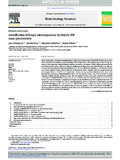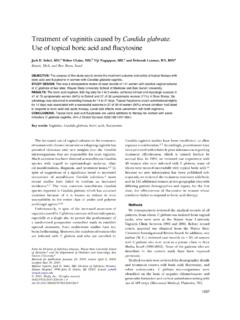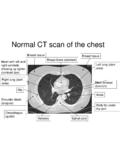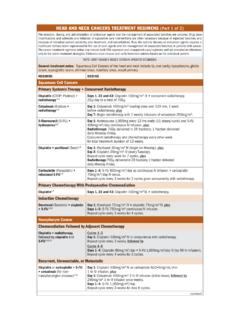Transcription of Review Administering amphotericin B—a practical approach
1 Journal of Antimicrobial Chemotherapy (1994) 33, 203-213. Review Administering amphotericin B a practical approach S. H. Khoo', Jeanette Bond* and David W. Denning**. Downloaded from at University of Manchester on November 26, 2012. "Regional Department of Infections Diseases and Tropical Medicine, Monsall Hospital, Manchester and bDepartment of Medicine, Section of Infectious Diseases, University of Manchester, Hope Hospital, Salford, Manchester, UK. Despite the introduction in recent years of novel antifungal agents, the potency and broad spectrum of activity of amphotericin B have ensured that it remains the treatment of choice for most deep-seated mycoses.
2 However, this agent is not without significant toxicity, particularly in patients who are already seriously ill and/. or who are receiving other potentially nephrotoxic drugs. We Review the various routes by which amphotericin B can be administered, focusing mainly on the intravenous route. The use of more rapid infusion rates, lipid-complexed prepara- tions, sodium supplementation in salt-depleted patients and stategies to reduce the incidence of infusion-related reactions and nephrotoxicity are also considered. Finally, detailed recommendations for the administration of amphotericin B are provided.
3 Introduction amphotericin A and B are polyene compounds which were originally isolated from the soil actinomycete, Streptomyces nodosus. amphotericin B is either fungistatic or fungicidal, depending on the concentration of the drug achieved in the serum or tissues and the susceptibility of the pathogen; its activity is maximal over the pH range 6-0-7-5. It has good in-vitro and in-vivo (clinical) activities against Candida spp., including Candida (Torulopsis) glabrata (but not the majority of Candida lusitaniae isolates), most Aspergillus spp., Cryptococcus neoformans, Histoplasma capsulation, Coccidioides immitis, Paracoccidioides brasiliensis, Blastomyces dermatitidis, Sporothrix schenkii and Rhodotorula rubra.
4 Its activity is limited against Trichosporin beigellei, Fusarium spp. and the aetiological agents of mucormycosis, and absent against Pseudallescheria boydii. amphotericin B has also been used as treatment for visceral and mucocuta- neous leishmaniasis and amoebic meningitis, but it possesses no antibacterial activity. More recently, derivatives of amphotericin B have been found to have some in-vitro activity against the human immunodeficiency virus (Hansen et al., 1990), although the clinical significance of this observation is uncertain. Despite its potential toxicity and the introduction of many novel antifungals in recent years, the potency and broad spectrum of activity of amphotericin B have ensured that it remains the treatment of 'Corresponding author Regional Department of Infectious Diseases and Tropical Medicine, North Manchester General Hospital, Delannay's Road, Manchester M8 6RB, UK.
5 203. 0305-7453/94/020203+11 $ 1994 The British Society for Antimicrobial Chemotherapy 204 S. H. Kboo el at. choice for most deep-seated mycoses. This Review focuses on the various routes of Administering amphotericin B and strategies for limiting its toxicity whilst, at the same time, preserving its efficacy. The clinical indications for the use of this agent and appropriate dosages are outside our remit and have been well-reviewed elsewhere (Meyer, 1992). Mechanism of action amphotericin B acts by binding to sterols in the fungal cell wall and altering membrane permeability, thereby allowing the leakage of cytoplasmic components which even- tually leads to cell death.
6 Despite a greater affinity for fungal sterols, it is likely that Downloaded from at University of Manchester on November 26, 2012. some of the toxic effects of the drug ( nephrotoxicity) result from damage to the host cell membrane. Acquired resistance to amphotericin is rare (Warnock, 1991) and routine suscept- ibility testing is considered unnecessary when treating most infections caused by Candida spp., Aspergillus spp., C. neoformans and the agents of mucormycosis (British Society for Antimicrobial Chemotherapy Working Party, 1991), unless there is failure of treatment or relapse, with re-isolation of the causative organism.
7 On the other hand, resistance may develop during therapy for infections caused by C. lusitaniae (Blinkhorn, Adelstein & Spagnuolo, 1989) or when prolonged courses of the drug have been administered ( for fungal endocarditis), under which circumstances suscept- ibility testing may be advantageous. Formulations Because it is relatively unstable, amphotericin B is commercially available as a complex with sodium desoxycholate (Fungizone, Bristol-Meyers Squibb). After reconstitution with distilled water, the mixture is diluted in 5% dextrose to give an infusion solution with a final concentration of up to 025 g/L (Ellis et al.)
8 , 1992). At concentrations of up to 1-4 g/L, the preparation is stable for at least 36 h (Kintzel & Kennedy, 1991). The addition of sodium heparin or hydrocortisone to the infusion does not affect its stability (Trissel, 1992), but electrolyte-containing solutions will cause the amphotericin to precipitate and diluents other than those recommended should therefore be avoided. The commonly-held belief that diluted solutions must be protected from light and used within 6 h does not apply to amphotericin B which is stable for at least 24 h when exposed to light at room temperature (Trissel, 1992). The efficacy of amphotericin B, notwithstanding the side-effects associated with its administration, has led to the development of several different formulations of the drug.
9 An attempt in the late 1970s to produce salts of the methyl ester resulted in a preparation which caused central nervous system toxicity (Ellis, Sobel & Neilsen, 1982). More recently, amphotericin B has been combined with a number of lipid compounds (Bennett, 1992) which are listed in the table. These lipid-associated preparations have been shown to have a reduced potential for causing toxicity in animal models, and probably in humans as well. The methods of preparation, storage and administration and the tissue distribution of each formulation differ from those of conventional amphotericin B and vary from product to product.
10 Although most preparations have reduced efficacies when compared with amphotericin B-desoxycholate on a dosage-for- dosage basis (three- to Tour-Told higher dosages Wing required to produce equivalent Table. Intravenous formulations of amphotericin B. Cost ( ) per Target dosage Formulation Manufacturer Carrier Colloidal type Current status 50 mg (mg/kg/day). Fungizone Bristol-Myers Squibb Sodium desoxycholate micelle licensed 370 0-5-1-5. Fungizone in 100 mL of Kabi Pharmacia lipid emulsion undergoing 10-25 ?l-5. 20% Intralipid clinical studies AmBisome Vestar Inc. DSPC? unilamellar licensed in Europe 119 1-4.)








